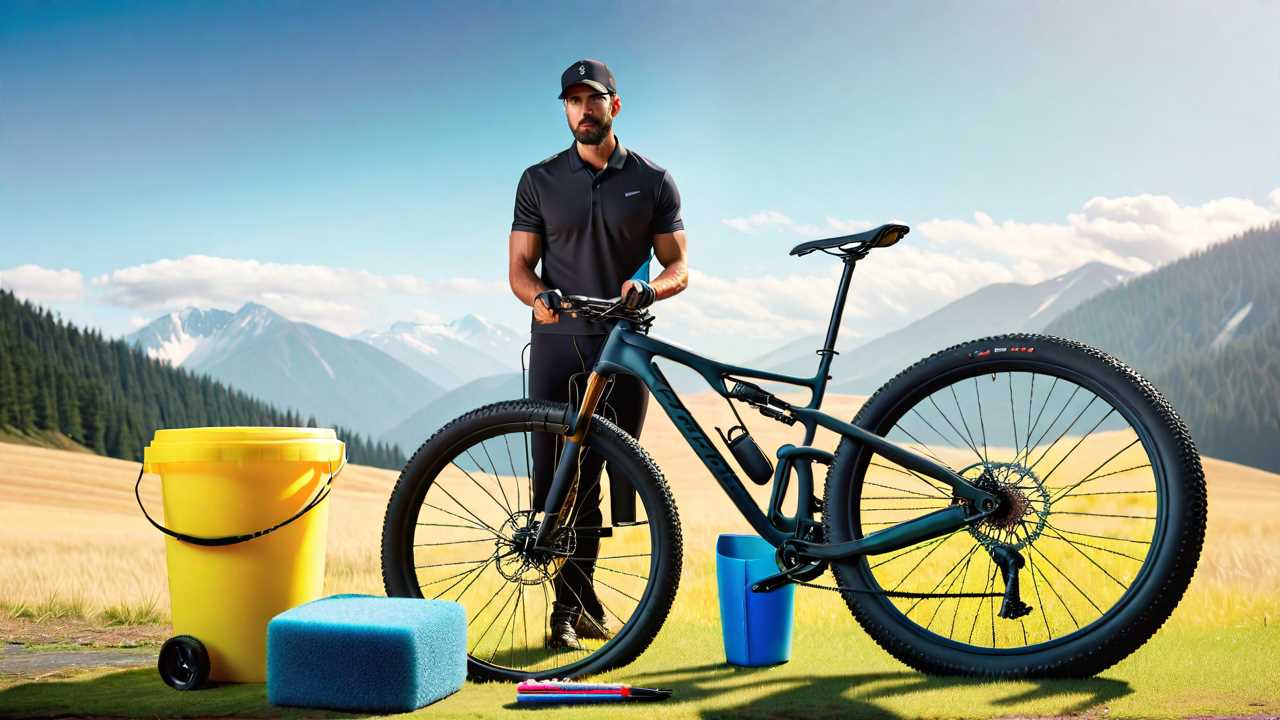
Did you know that properly maintaining your mountain bike can extend its lifespan by up to 50%? Taking care of your bike is essential for peak performance and safety on the trails. From cleaning and lubricating to checking brakes, suspension, and drivetrain components, a well-maintained bike guarantees a smooth and enjoyable ride. But what specific steps should you take to keep your mountain bike in top shape? Let's examine some key maintenance practices that will help you get the most out of your two-wheeled adventure companion.
Cleaning and Lubricating Your Bike
To properly maintain your mountain bike, begin by thoroughly cleaning and lubricating it regularly. Cleaning your bike involves removing dirt, grime, and debris that can cause wear and tear on your components.
Start by using a gentle brush or sponge with soapy water to clean the frame, wheels, and drivetrain. Be sure to rinse thoroughly to remove all soap residue.
After cleaning, it's essential to lubricate key parts of your bike to guarantee smooth operation. Apply a bicycle-specific lubricant to the chain, derailleurs, and cables. Wipe off any excess lubricant to prevent attracting dirt. Additionally, lubricate pivot points on brakes and derailleurs for best performance.
Regularly inspect your bike for signs of wear and tear, such as rust, fraying cables, or loose bolts. Address any issues promptly to prevent further damage.
Checking and Adjusting Your Brakes
Guarantee the safety and performance of your mountain bike by regularly checking and adjusting your brakes. Start by inspecting the brake pads for wear. If the pads are less than 1/8 inch thick, replace them immediately to maintain peak braking power.
Next, check the brake levers for any looseness or damage. Tighten any loose screws or bolts and replace any damaged components.
To adjust the brakes, begin by aligning the brake pads with the rim of the wheel. They should make even contact with the rim when the brake is engaged. Adjust the cable tension using the barrel adjuster until the pads are properly aligned.
Test the brakes by squeezing the levers to ensure they engage smoothly and stop the wheel effectively.
Regularly clean the braking surface of the rim to prevent debris buildup that can impair braking performance. Additionally, lubricate the pivot points of the brake calipers to ensure they move freely and smoothly.
Inspecting and Maintaining Your Suspension
Regularly inspecting and maintaining your suspension system is crucial for peak performance and comfort while riding your mountain bike. Begin by checking for any signs of oil leakage around the seals and inspect the stanchions for scratches or nicks that could damage the seals.
Clean the stanchions with a soft cloth to prevent dirt from entering the seals. Next, confirm the sag is set correctly based on your weight and riding style. Adjust the air pressure or spring tension accordingly.
Periodically, check the suspension bolts for tightness and inspect the linkage bearings for any play or resistance. Lubricate the pivot points as needed to keep the suspension moving smoothly.
Additionally, consider servicing the suspension forks and shocks annually or as recommended by the manufacturer to maintain peak performance.
Keeping Your Bike's Drivetrain in Shape
Check your bike's drivetrain regularly to guarantee peak performance and longevity. The drivetrain is a vital component that includes the chain, cassette, chainrings, and derailleurs.
Here are some key steps to keep your bike's drivetrain in top shape:
- Clean the Chain: Use a chain cleaner tool and a degreaser to remove dirt and grime from the chain. Wipe it dry and lubricate with a bicycle-specific chain lube.
- Inspect the Cassette and Chainrings: Look for signs of wear such as teeth that are hooked or worn down. Replace the cassette and chainrings if necessary to prevent premature wear on the chain.
- Adjust the Derailleurs: Ensure that the derailleurs are shifting smoothly and accurately. Make adjustments using the barrel adjusters if the shifting isn't precise.
- Monitor Chain Wear: Use a chain wear indicator tool to check the elongation of the chain. Replace the chain before it wears out to avoid damaging other drivetrain components.
Frequently Asked Questions
How Often Should I Replace My Mountain Bike's Tires?
You should replace your mountain bike's tires every 500-1000 miles depending on the terrain you ride, tire type, and conditions. Check tread wear, cuts, and sidewall condition regularly. Proper maintenance guarantees peak performance and safety.
Can I Use WD-40 to Lubricate My Bike Chain?
If you're considering using WD-40 to lubricate your bike chain, it's best to avoid it. While it may offer temporary relief, it's not a suitable long-term solution and can actually attract dirt, leading to quicker wear and tear.
Should I Store My Mountain Bike Indoors or Outdoors?
Store your mountain bike indoors to protect it from weathering and theft. A dry, cool space like a garage or shed is ideal. Hang it vertically or use a bike stand to prevent damage and save space.
Is It Necessary to Bleed Hydraulic Disc Brakes Regularly?
Regularly bleeding hydraulic disc brakes is essential for peak performance. Air bubbles can impact brake responsiveness. To guarantee safety and efficiency, it's advisable to bleed your brakes at least once a year or if you notice any sponginess.
Can I Wash My Mountain Bike With a Pressure Washer?
Sure, you can wash your mountain bike with a pressure washer, but be cautious. Use low pressure and keep a safe distance to avoid damaging delicate parts. Aim at a downward angle and avoid direct spraying on bearings and seals.
 SportsHollywoodLifestyleFashionHome & GardenTrendsPrivacy PolicyTerms And Conditions
SportsHollywoodLifestyleFashionHome & GardenTrendsPrivacy PolicyTerms And Conditions
